Primer izveštaja – Izveštaj za Marka
Example of final report – Mark
Name of Child: Mark
D.O.B: 09/05/2009
CA on last assessment session: 13;00yrs
Address: ####
Date and venue of recent assessment sessions:
- 25/02/2022: Call to mother
- 01/03/2022: Face to face session
- 11/05/2022: Face to face session: Trial start
- 26/05/2022: Face to face session: Trial end
- 04/08/2022: Online session (AT Team Speech therapist, mother and Mark’s speech therapist)
Assessment Team
- AT TEAM: Core Team Speech and Language Therapist)
- AT TEAM: Team Occupational Therapist)
- Mark’s Special Educator
- Class teacher
- Mother
Background Information:
Mark is a 13-year-old teenager with autism (report dated December 2013 signed by Child Psychiatrist During this episode of care, Mark was attending mainstream school on a full time basis.
Mark is a child who demonstrates a range of likes. He enjoys YouTube, songs, swimming, swinging, jumping, ball play, outdoor activities such as walking and gardens as well as massages. He dislikes tabletop activities and can get distressed when presented with new activities. He also dislikes going to churches.
Mark accesses speech and language therapy through the school with the school speech therapist who was keen for Mark to be considered for AAC. His speech and language therapist wanted him to be reviewed as she highlighted the need for Mark to develop a language system which would support him to communicate with everyone around him.
This report therefore deals with recommendations following a full assessment of Mark’s speech, language and communication.
Assessment Results
History of AAC systems
Mark’s speech and language therapist recommended using signing 12 months ago. She chose 5 signs: MORE, MUM, EAT, PUZZLE, BYE. After 12 months Mark is still unable to make the signs independently. He allows physical prompting to make the sign but does not imitate. Mark’s mum has not used the signs at home. At school the signs were used on some occasions.
Current communication skills
Speech/language history
Mark attends for speech and language therapy on a regular basis. Therapy has focussed on establishing some form of AAC use to support Mark to communicate with those around him. Furthermore, the speech therapist has worked on comprehension of nouns and verbs.
Receptive language skills:
The expert for speech and language disabilities has reported that due to Mark’s attention and interest levels she has not assessed his comprehension formally Mark’s performance on such tasks is appears inconsistent as it is impacted by his allention levels on the particular day. She reports, however, that single word comprehension appears to be established. Parental report indicates that he is able to follow commands within established routines. He is also able to understand some gestures.
Expressive skills:
Mark is able to say some words very occasionally. He says the word ‘daddy’ consistently but this is also used to request information Ca his mother. He also says the words ‘give me’ and ‘milky’. Other words have been heard only on a single occasion. These words have been uttered in situations in which he was stressed or angry. Mark’s mother noted that when he does say a word he appears surprised. As Mark uses less than 10 words consistently and functionally he is considered to be a minimally verbal communicator with complex communication needs.
The Pragmatics Profile for People who use AAC was administered through parental interview with Mark’s mother in the last session. This provides information on how Mark communicates as well as the communicative functions he is already able to fulfil. Apart Ca the few words which Mark can use, for the most part, Mark uses non-verbal communication as his main mode of communication. This includes facial expressions and the use of his own body. He also uses some vocalisations and pushes/pulls adults and objects to communicate in a variety of ways. Overall, the assessment indicates that Mark is an active communicator who is interested in interacting with others once engaged and can initiate communication for some communicative functions.
Mark demonstrates like or dislike of activities and objects. Likes are communicated through laughing and smiling. Mark’s mother noted that he has clear facial expressions which are easy to interpret. He also demonstrates that he likes an activity/object by going to it himself once he knows what is going to happen. Dislike, on the other hand, is communicated through crying and frowning. When he particularly dislikes something this may escalate to throwing himself on the floor, pushing people away and scratching.
More recently Mark has begun to demonstrate that he is interested in interactions with others. His mother reported that he now wants her to sit with him while he is watching cartoons. She reported that he looks for her and pulls her towards the sofa. To get an adult’s attention, Mark points and vocalises. For his mum he may verbalise /a/ or say ‘daddy’.
Mark is able to fulfil a number of communicative functions relating to requesting. He may request a person as described in the preceding paragraph. He may also request cessation by leaving the situation himself or by pushing undesired objects away. Mark enjoys playing with a string but noted that at times the stimming overwhelms him. When she tries to stop him Ca stimming with the string he may push her away. Mark is also able to request assistance. He may come to a parent for help with dressing or toileting. It is noted that Mark also brings objects to request e.g. wet wipes for toileting. Although Mark will try to get what he wants himself, he is able to request objects and activities in other ways. Mark may bring objects to make his needs known. His mother reported that in the last year he learned how to point to request using his index finger. He also pulls his mum by the hand to places to get desired objects. If the object is out of sight he will physically position his mum in a place where she can see it. His mother noted that while he will either try to get what he wants himself or use very clear communication to request what he wants there are days when he does not do this. She noted that on these days he may cry to request.
Mark is able to communicate about changes in his environment. When he notices a change e.g. decorated bedroom, he runs between the adult and the new thing and laughs. To communicate rejection of people Mark removes himself Ca the situation. To reject objects Mark pushes objects away. Occasionally Mark verbalises ‘no’.
Mark understands the concept of ‘no’. In extreme situations he may throw himself on the floor to protest. This could be accompanied by crying.
Functional Communication Needs:
Mark urgently requires a communication aid to support him to develop an array of communicative functions. Given that Mark is already communicating informally to meet some communicative functions, aided AAC could support him to develop communication that would address other functions of communication. It could also support him to clarify his communication in times of communication breakdowns Furthermore, aided AAC would support him to develop the language he needs at home and at school.
- To be able to communicate for requesting
- To learn to negate
- To learn to greet others
- To learn to express an opinion
- To give information about himself
- To ask and answer questions
Sensory Perceptual Skills:
Mark has adequate vision to learn to use an AAC device. Hearing is also adequate.
Functional Mobility:
Mark ambulates independently and is able to carry an AAC system.
Fine Motor Skills:
Mark can use his index finger to point to items across the screen. He showed insecurity to touch items on the screen and he tends to engage in tapping on the screen. Poor grading of movement was observed. A touch guide and visual contrast were put in place and this helped Mark to locate the items well.
Oral-motor skills:
Mark does not currently present with sufficient verbal output to meet his communicative needs. He is an intermittent speaker only using verbal language on occasion for the most part. He says less than 10 words and many of these are unintelligible to unfamiliar speakers. His mother described a profile of speech which involves a limited consonant inventory and which is only understandable to her due to Mark’s intonation and the presenting context.
Reading/writing skills:
Mark does not demonstrate interest in books or story telling although he sits for these activities in the classroom.
Mark presents with emerging literacy skills. He is able to match a letter to a picture of a word beginning with that letter. He also matches written words to pictures. Mark demonstrates some basic comprehension of written words.
Mark is able to find a letter on a keyboard when a cardboard window is used which exposes 3 letters at a time. Using this method he can type by copying. He is confident to carry out such activities that include copying of CVC words.
Some minimal hand on hand prompting and guidance is required in literacy activities.
Sensory processing:
Mark presents with sensory processing differences. He present with poor registration of proprioceptive input and this might be one of the reason that he was applying extra tapping on the screen. He also tends to seek this input through requesting deep pressure on his head, arms, legs and feet and back. He will guide you on which body part he want the pressure e.g. by pulling your hand to his head. He also seeks visual input and he likes to look at moving strings. Mark needs heavy work activities and deep pressure to be at the just right level to be ready to learn the use of an AAC system and to communicate with others. Once he is organised he is able to request his needs, notice things in his environment and interact with others.
Previous history of technology use:
Mark has access to a mainstream tablet which he likes to use to watch YouTube. His current AAC app is downloaded on the same tablet. Mark’s mother recognises that this has created a stressful situation for Mark as using the tablet for communicative purposes means he has to stop using his favourite apps. For this reason amongst others, Mark a separation of technology for leisure versus communication should be considered if high tech AAC is suitable for AAC use. Mark does not have any history of tablet breakage but is extremely attached to it for YouTube.
System Features:
In accordance with assessment, Mark requires a communication aid which includes the following:
- Access to a full language system to support Mark to express himself to fulfil a variety of communicative functions
- Motor planning based vocabulary organisation to facilitate fast communication
- English language based system which is in line with Mark’s language preference
- A system which provides access to both visuals and literacy. Initial emphasis on graphic symbols.
Voice output with a child’s voice - Robust enough in the case of falls and knocks and rough handling
- Ability to only provide access to communication
- Can add a keyguard/touchguide
Device assessment:
Words for Life (WFL) was considered as a system of vocabulary organisation in as it was felt that the motor planning would support quicker language output than the current ACA app Let me Talk. Initial assessment was carried out using WFL on an Via®Pro. This is an AAC device consisting of a mainstream tablet (iPad) with an 11.2” display with a cover designed for communication as it amplifies voice output. The cover also is capable of withstanding knocks and drops. Five words were unmasked: MORE, STOP, EAT, DRINK & PLAY. A touchguide was also added as Mark demonstrated multiple tapping behaviours. It was also trialled as it was felt that it might support him to locate vocabulary. Physical prompting in the form of a touch on the elbow supported him to locate the vocabulary. Mark was offered a trial of a communication aid with Words for Life software as there was a need to see how he would perform with a communication aid at home.
For the trial an Accent 1000 with Words for Life was loaned to Mark and his family. This was chosen because of the screen size which was similar to the Via®Pro. The following words were unmasked: EAT, DRINK, PLAY, OPEN, MORE, GO, STOP, I, WANT as well as some fringe vocabulary to reflect what Mark might want to request. Mark was a little hesitant to enter the room initially but eventually settled down and interacted with the therapists during a massage activity. He also played with a ball and a balloon. All communications were partially prompted during the session. His mother contributed to the session with suggestions on how the vocabulary could be used in the home setting. She also confirmed that she had watched the videos at the links that were sent after the first session. Trial diaries were provided to the mother and school. Goals set for the trial were as follows:
- All adults to use Aided Language Input
- To focus on requesting. Use of prompts was accepted.
- Focus on communicating single words
- Strategies for the trial were communicated to all adults and included:
- Support navigation if required
- Use waiting to give Mark a chance to use the communication aid
- Use hand under hand prompting if prompting is required
- Use gestural prompting as the first prompt to show Mark where to locate vocabulary on his communication aid
The trial was for a 2 week period.
When the trial ended a review was carried out at the AT Resource Centre. The full vocabulary had been unmasked in error although Mark did demonstrate some interest in the keyboard. Although initially overwhelmed by all the vocabulary, he was able to locate familiar words. His mother reported that he liked the spelling page and he enjoyed watching her spell words. During the trial, he learned to use DRINK and COKE independently although sometimes he required support with the first hit in the sequence. In session it was noted that multi-tapping had decreased. He was observed to randomly use the device on some occasions but on other occasions the activation of voice output was with intent. He activated the following independently: MORE, PLAY, I, MASSAGE, OPEN, and some body parts vocabulary. Mark’s mother tended to use gestural prompts to support him to locate vocabulary although observations indicated that he could manage with a gestural prompt. All adults present agreed that Mark had made good progress during the trial and was beginning to understand that this is a communication aid to be used for communication. He was able to use the communication aid to make a choice of food during his lunch break at school.
He also requested toilet at home and refused to go until he had communicated this. Of note, is that Mark also started to demonstrate some ability to answer questions as he was able to communicate a colour label when asked the colour of an object. He also accessed feelings vocabulary. He generally appeared happy using the communication aid and for the most part achieved the goals of the trial that were set. Mark’s mother provided the team with a list of vocabulary that she felt he would benefit Ca going forward. She was extremely keen to move forward with Words for Life as the vocabulary.
As Words for life is available on many platforms, a discussion ensued about the differences between the platforms, Apple iPad was rule out due to Mark’s attachment to YouTube. Mark’s access was assessed on both an Accent 800 which is both lighter and smaller than an Accent 1000. He was also assessed on a NovaChat 8. No differences with access were noted. The mother chose the Accent 800 because a clear touchguide can be put on the display. This is not possible for the NovaChat as this only comes with a black keyguard.
Recommendations:
1. Mark demonstrates excellent potential to learn to use an AAC device. Over the course of the trial he achieved all the goals that were set. His family, educators and therapists demonstrated their commitment to the process. In view of this a communication aid is being recommended to support Mark to develop a formal system of communication.
2. AAC device prescription:
Mark requires a robust AAC device that can take knocks and bangs. He also requires a device which has access to a system of vocabulary that would allow him to develop his language for a variety of communicative functions. Vocabulary needs to take a motor planning approach to support him to locate the vocabulary with minimal navigation. The device must be dedicated to prevent him Ca accessing other computer functions.
Product
1. Accent 800 with Words for Life and Acapela voice Harry: Black
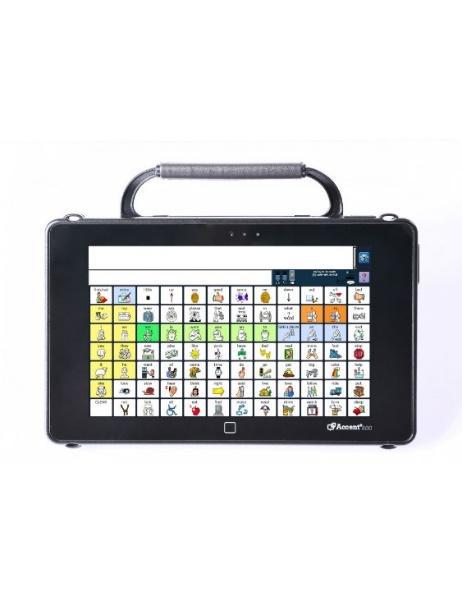
Description:
The Accent 800 is a dedicated AAC device with a battery life of 8-10hrs. It also has a daylight readable 8” display and complies with military grade drop. Using settings within the device the software will be configured to automatically load on to the Words for Life software and to prevent the device use for any other function.
Product
2. 84 location touchguide for Words for Life
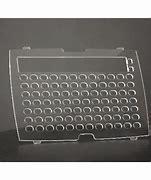
Description:
This supports Mark to be more organised when accessing vocabulary on the device.
Product
3. Liberator small device carrybag
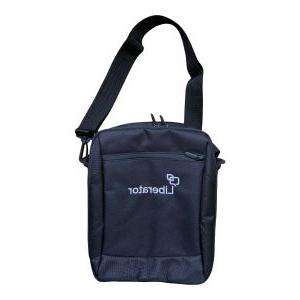
Description:
This bag is designed to fit the Accent 800.
Product
4. Carry strap for Accent 800
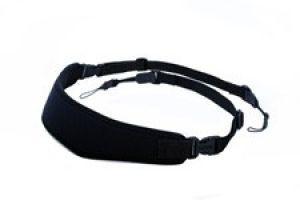
Description:
This strap is designed to be attached to the Accent 800 for ease of carrying
Product
5. Extreme case for Accent 800-30: Red
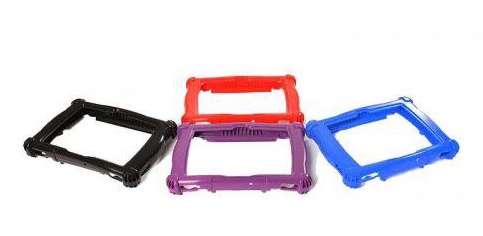
Description:
This case would protect the Accent-800 Ca rough handling
Product
6. Libcare extended warranty
Description:
Extended warranty by 1 yr in the event of breakage
3. Aided language input together with the provision of communication opportunities is recommended to support Mark to learn to use the AAC device. A useful video can be found here: Aided Language Stimulation Explained – YouTube. A second video which details exactly how such modelling can be provided is available here: Aided Language Stimulation Explained – YouTube.
4. Teaching Mark to communicate with his AAC device needs to be embedded in everyday scenarios which provide him with a motivation to communicate and which would be intrinsically rewarding. Some basic ideas on this can be found here: Parents’ and Teachers’ Guide to Getting Started with AAC – Speech And Language Kids
5. Vocabulary selection for the initial stages should focus on some core words with some fringe vocabulary. Core words are words that Mark can use in many situations. Information on core words can be found here: https://www.assistiveware.com/blog/teaching-core-words-building-blocks-communication-and-curriculum. A useful resource entitled Teaching Core Words Across the Day can be found here: https://www.liberator.co.uk/media/pdf/TeachingCoreWordsAcrosstheDay-2019.pdf. Discussions on goal setting with both the mother and the speech and language pathologist have already begun.
6. Mark’s family and speech and language pathologist will be provided with support to implement the AAC device with Mark.
7. ACTU therapists can be contacted for general information and support on how to implement the AAC device.
8. Mark will be discharged Ca ACTU services if no contact is made Ca the family within 12 months of the date of this report.
